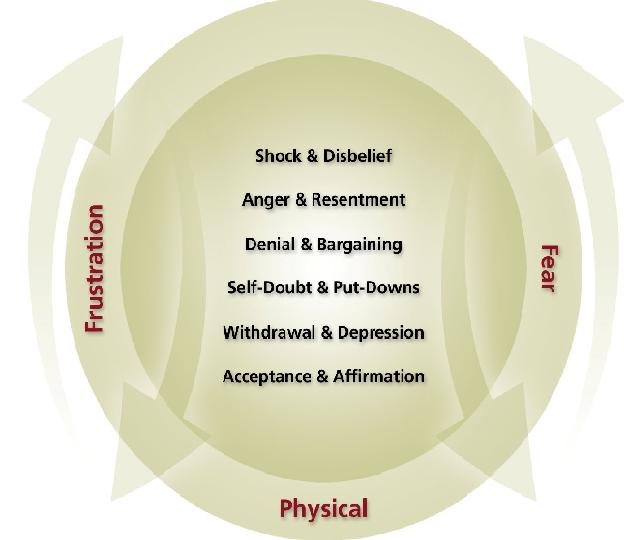|
|
 |
And it is a perfectly normal reaction cycle.
Our research also shows those who accept this Cycle as a normal reaction to layoff are those who turn job hunting into job-getting more quickly.
Why? Because when they wake up one morning and feel “down” they know it’s natural. They’re OK, just experiencing part of the job loss cycle. When anger surfaces they know anger happens It’s part of the transition to Acceptance and Affirmation. It’s normal. So they deal with it, instead of letting it simmer. Or push their negative reactions inward, which does no one any good.
Here’s what the Job Loss Cycle looks like:

Everyone goes through it. It’s not a matter of “If” but “When and How?” And as the arrows indicate, it’s an up and down reaction cycle. It’s not a static, “Deal with one phase before moving on to the next.” Instead, it’s dynamic, and people move up and down the Cycle continually until they remain in Acceptance and Affirmation. People have reported that in the first few days they moved up and down the cycle several times in one day. That too, seems to be normal.
Here’s what each phase involves and how to move on to Acceptance and Affirmatioin.
Shock & Disbelief is the realization that one’s job has been eliminated. It typically doesn’t last long. For some, just a few minutes. “When I heard my boss say my job had been eliminated, my mind went blank,” is a very common reaction. There’s the shock of job loss. The momentary disbelief that it is really happening. Job loss doesn’t just happen to others. “It happened to me.”
For some people the disbelief can last for hours. For others, just a few minutes.
How move on? Stop and think for a moment. What were you told? What kinds of assistance is being provided? For some people after they hear the words “Your employment with us ends today…” things kind of go blank.
Anger & Resentment often quickly follows and is usually focused toward the key decision makers directing the downsizing. After all, how could they do this to me? It isn’t fair. It upsets my plans for the next several years. I’m damn mad.
If not dealt with, anger can turn inward. Not good.
The anger can also be directed to the immediate supervisor, because that person no doubt was part of the decision making that led to the layoff. Sure, the people with the big offices were involved, too. But it’s not fair.
Denial & Bargaining is a form of wishful thinking, as a person tries to figure out ways to stay with the organization. Or sits and waits to be called back. Or goes back again and again telling the decision maker how much the person can now contribute. It is a waste of time and energy.
Self-doubt & Put Downs is a natural consequence of the job loss experience. People ask themselves questions like, “What could I have done differently?” and “Why didn’t they recognize my contributions?” They begin to question their abilities and skills. How get out of it?
Focus on what you do best, which is what you most enjoy doing. Take time to identify the results of your work. Learn to ask “So what?” for each task in your past job and push yourself to come up with accomplishments. Then read these over frequently. You won’t have time to put yourself down because you can talk about your many accomplishments.
Withdrawal & Depression sets in when the person realizes it is hard work turning job hunting into JobGetting. Nothing much seems to be happening. When Richard went through job loss he did his wash at 10 in the morning, because he knew his friends would all be at work. He did his grocery shopping at 1am in the morning because he knew his friends would all be at home asleep.
Acceptance & Affirmation is when
a
person can say something like, “Didn’t like it, but I have lots to
contribute
and now my job is to find a place where I can be fully satisfied and
fully
productive at the same time.”
In working with thousands of people
who’ve
lost their jobs, we’ve encouraged people to resolve:
“A year from now I will be in a better
position than I am today. And
I can go
back and thank the person for the favor done to me which led to this
new
venture.”
Over
90% of
them do. And it
begins by understanding
the job loss reaction cycle everyone goes through.
Most of the people we’ve worked with over
the years get to Acceptance and Affirmation rather quickly. That’s because the focus
is on each person’s
accomplishments, the results of her or his work, the successes a person
has
had. After
all, when you focus on what
you’ve done well, it’s not difficult to be positive.
And energetic.
-------
This is a summary of the book chapter “What Can I Expect Now?” from Make Job Loss Work For You (JIST Publishing, 2020). Understanding the Deems Job Loss Reaction Cycle™ and keeping track of where you are in the Cycle gives you an edge in turning job-hunting into JobGetting.
Back to Articles2012 WorkLife Design ~ All Rights
Reserved
Website developed by Renewed Web Presence

